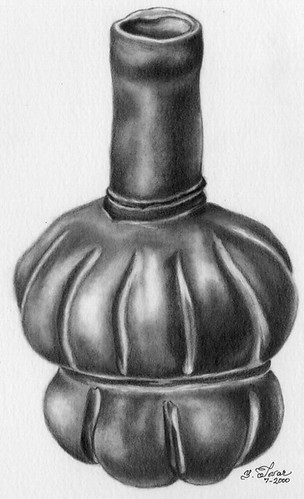The Birth of Chocolate

High-necked jar in the shape of a cacao pod, corresponding to a type produced and probably used for serving an alcoholic beverage made from cacao pulp between 1400 and 1100 B.C. at Puerto Escondido (Honduras). Chemical analyses by the author’s laboratory and colleagues support this conclusion. (Drawing courtesy of J.S. Henderson and Y. Tovar; Collection of the Instituto Hondureño de Antropología e Historia, Museo de San Pedro Sula, Honduras; drawing by Yolanda Tovar).
Our ancestors might well have brought traditions of how to make a fermented beverage with them to the New World, but they were also faced with harnessing the resources of a host of new plants– maize or corn, cacti of all kinds, manioc or cassava and squash, and much, much more. Chocolate or cacao is an excellent example of how a new alcoholic beverage was discovered and put to use, and likely led on to the domestication of the tree (Theobroma cacao = “food of the gods”).
A sweet pulp fills the warty-looking fruit of the criollo variety, native to Central America. This sweet pulp, with as much as 15% sugar, that might well have first attracted our ancestors. Fermentation of ripe fruit occurs naturally, and produces a 5 to 7% alcoholic beverage. In fact, the beans are still freed from the pod this way in modern chocolate production. The Spanish chroniclers observed that native peoples along the Pacific coast of Guatemala delighted in a mildly alcoholic beverage, which they made by piling cacao fruit into their dugout canoes and letting it ferment there.
The Puerto Escondido analyses of 11 pottery sherds support this scenario that a fermented beverage initially attracted humans to the tree. One vessel, a long-necked jar which tested positive for theobromine (uniquely found in cacao in Central America), advertised its contents: it has the shape and characteristic ridges and indentations of the cacao pod. This jar was likely filled with a fermented chocolate beverage made from ripe chocolate fruit.
Like grape wine, rice wine, and barley beer in the Old World, chocolate “wine” went on to become the prerogative of royalty and the elite generally, and a focus of religion in the New World. Cacao beans also served as money for the Aztecs, and King Montezuma had a veritable Fort Knox in his storerooms at Tenochtitlan–nearly a billion beans, according to one Spanish informant.
Many of the most stunning pottery vessels from Mesoamerica were made to hold the beverage.
In later Mesoamerica, the Mayans and then the Aztecs increasingly turned to the beans, rather than the fruit, to make their cacao beverage. They also mixed in lots of additives–honey, chilies of all kinds, variously scented flowers, and achiote or annatto (Bixa orellana) which colors the beverage an intense red in keeping with its association with human sacrifice. If a victim atop one of the pyramids faltered, he was given a gourd of chocolate, mixed with blood which had been caked on the obsidian blades of earlier sacrifices.
This later drink was often frothed to give a high head of foam. The idea was apparently to inhale the foam at the same time that one drank the liquid directly from the mouth of the vessel. The most distinctive vessel type for consuming the new chocolate drink was a “teapot” whose spout was bent backwards, impossible for pouring a liquid but serviceable for inhaling a foam.
Our research on ancient chocolate was carried out in collaboration with Jeff Hurst of Hershey Foods Technical Center. Another new collaboration, fitting our general research model of using state-of-the-art instrumention, is with Mattanjah de Vries at the University of California at Santa Barbara. He uses resonant ionization mass spectrometry to study the fingerprint compounds of cacao–theobromine and caffeine.
P. E. McGovern, J. S. Henderson, R. A. Joyce, G. R. Hall, and W. J. Hurst
2007 Chemical and Archaeological Evidence for the Earliest Cacao Beverages. Cover article of The Proceedings of the National Academy of Sciences USA 104.48: 18937-40.
